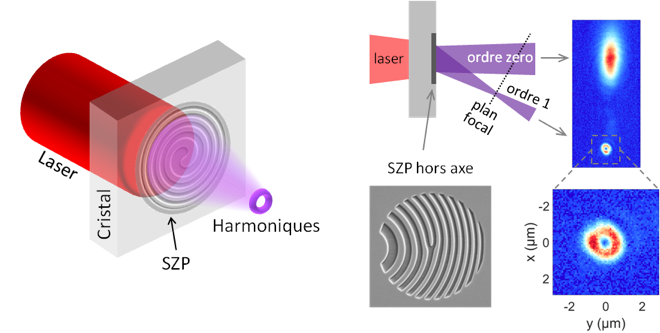Willemn Boutu (LIDyL), Marc Hanna (LCF)
Laser beams carrying optical angular momentum (OAM) have led to various applications in many fields, from quantum information technologies to microscopy. Such beams are mainly created in the visible domain. Their recent extension to the XUV domain through high order harmonic generation opens the way towards the creation of nanometer size vortices.
HHG is here produced by focusing a femtosecond laser pulse inside a semiconducting crystal at high intensities (1011 to 1013 W/cm2). In HHG in semiconducting crystals, the physical mechanisms are different from those in atomic or molecular gases because of the large density of emitters, of the electronic band structure and the crystal symmetries. Thanks to the solid state nature of the emitting medium, miniaturizing XUV attosecond sources (1 attosecond = 1-18 second) becomes possible, as well as their integration inside optoelectronic devices. Using this radiation for applications requires to control and to shape the generated light. We recently demonstrated that optical vortices with various topologies could be generated. Those OAM beam have a helical wave front around a phase singularity and an annular intensity profile. To generate such nanometric vortices, we nano-structured on the exit side of the semiconducting crystal (ZnO) a spiral Fresnel zone plate (SZP). This SZP combines focusing and OAM manipulation to create a focused optical vortex (left hand side figure). We studied those autofocusing OAM beams in several configurations, among which an off axis geometry that generated a vortex with a 400 nm inner diameter with an excellent contrast in the first order (right hand side figure). Other geometries based on metasurfaces could be used to manipulate light beyond the diffraction limit, in order to control for instance the polarization and the OAM. We foresee many potential applications in optical trapping, quantum technologies at the nanometer scale or writing topological magnetic domains.

Left: Principle of laser harmonic generation in a semiconducting crystal. The spiral Fresnel zone plate on the back side of the crystal creates an optical vortex. Right: Experimental result with an off axis SZP (SEM image of the structure in inset). Experimental intensity distribution of harmonic order 5 on the focal plane at zeroth and first diffraction orders, where the annular intensity profile of the optical vortex is clearly visible.
David Gauthier, Shatha Kaassamani, Dominik Franz,Rana Nicolas, Jean-Thomas Gomes, Laure Lavoute, Dmitry Gaponov, Sébastien Février, Gaëtan Jargot, Marc Hanna, Willem Boutu and Hamed Merdji. Orbital angular momentum from semiconductor high-order harmonics. Optics Letters 44, 546 (2019)
Results obtained in the framework of the project High repetition rate Laser hArmonics in Crystals (HILAC) funded by topic 3 of LabEx PALM coordinated by Willem Boutu (LIDyL).